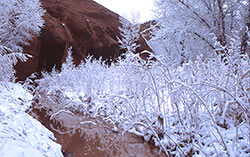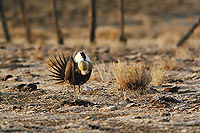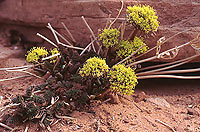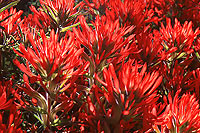 It’s been a long winter in Canyon Country. Snow and ice were fairly common, but also punctuated by sunny days and not-so-cold temperatures. Winter makes for challenging times when exploring the canyons and trails in the region but it also makes the approach of spring that much sweeter.
It’s been a long winter in Canyon Country. Snow and ice were fairly common, but also punctuated by sunny days and not-so-cold temperatures. Winter makes for challenging times when exploring the canyons and trails in the region but it also makes the approach of spring that much sweeter.
Besides out-of-state license plates and an influx of college-aged backpackers and climbers, a number of other subtle signs reveals that spring is near.
When Willows Bud
Male flower buds, better known as “pussytoes”, begin to swell and open on the coyote willows which grow along riverbanks and canyon bottoms. These clusters of flowers, known as catkins, have both male and female flowers. The male flowers have stamens loaded with pollen which will eventually be wind-transported to the female flowers found on separate plants. This type of arrangement is called “dioecious” which means “two homes” for the male and female plants.
 When Grouse Dance
When Grouse Dance
Out in the sagelands east of Monticello, spring is the time when sage grouse dance. A small population of Gunnison sage-grouse gathers at breeding areas called “leks” (from a Swedish word meaning “mating grounds”) where the males perform very elaborate displays to attract the attention of the sage hens. The males raise and fan out their tail feathers, inflate two yellowish air sacs on their chest, and strut forward while making “popping” sounds. This ritual has been happening for thousands of years out in the sage; the grouse’s life cycle is directly tied to the health of the sagebrush.
The majority of the birds perform on private land, so viewing this incredible display is a challenge. Colorado, which hosts the majority of the population, has better opportunities to view these birds. Only a couple of the dominant males will breed with the females, who will later build a nest in the protective confines of some dense sagebrush to raise their brood.
When Wildflowers Bloom
March is the period when wildflowers start to emerge in the Canyon Country. Several members of the Carrot Family, the Canyonlands biscuitroot, Parry’s lomatium, and Fendler’s spring-parsley reveal their flat umbels of tiny flowers growing low to the ground which are pollinated by early-season insects.
Roadsides may have substantial blooms of woolly locoweed, named for the numerous hairs that cover the leaves, giving the plant a “woolly” appearance. The locoweed name originates from livestock ingesting too much of these plants and their phytotoxin, swainsonine, which is toxic to livestock, and deer and elk.
Probably one of the first “noticeable” wildflowers in spring are the paintbrush, with their vibrant reddish flowers set against the sandstone. Though these plants may attract hummingbirds as pollinators, they are also semi-parasitic, drawing nutrients from nearby shrubs.
When Birds Migrate
American robins have often been credited as the “birds of spring,” but in reality, they are year-round residents. Other species return to the region from their wintering grounds farther south; many of these birds overwinter in Mexico, Central America, or as far south as Argentina.
 Swallows and swifts are aerial insect-eating specialists that return as the weather warms. Turkey vultures and Swainson’s hawks are two large birds of prey whose return signals spring is on the way. The vultures rely on carrion as a food source and the Swainson’s hawks, which winter in South America, shift their winter diet of grasshoppers and large insects to small mammals, rodents, and birds.
Swallows and swifts are aerial insect-eating specialists that return as the weather warms. Turkey vultures and Swainson’s hawks are two large birds of prey whose return signals spring is on the way. The vultures rely on carrion as a food source and the Swainson’s hawks, which winter in South America, shift their winter diet of grasshoppers and large insects to small mammals, rodents, and birds.
When Shrubs Flower
Not to be outdone by spring wildflower blooms, numerous shrubs also produce blooms in spring, such as Utah serviceberry and skunkbush or three-leaf sumac. These shrubs often bloom before their leaves emerge and their flowers contribute to the signs that spring has sprung.